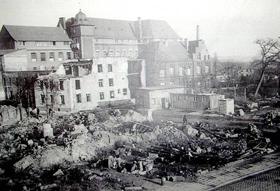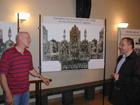




 [Rundweg Religion]
[Rundweg Religion]
History of Dorsten - Station 9: St Agatha - In the Town Centre - In the Centre of Life

The history station "The History of Dorsten - Station 09 St Agatha was officially opened during the celebrations of the consecration of the church. From 29th June (Peter and Paul) until 7th July, the parish holds a week's celebrations in memory of the consecration of the newly-erected St Agatha Church and right at the beginning, presents the new history station, positioned in front of its door, to the town of Dorsten.
"It's about the people who celebrate their faith here, it's about the people, who live in the centre of the town and perceive the St Agatha Church and Parish from the outside", (From the Jubilee Parish Newsletter) ("Es geht um die Menschen, die in diesem Raum ihren Glauben feiern, es geht um die Menschen, die mitten in der Stadt leben und die St. Agatha-Kirche und die Gemeinde von außen wahrnehmen", (Jubiläums-Pfarrbrief))
Members of the congregation and visitors were informed by pictures and information, presented in the tower and on the inside-walls of the church, about the destruction and reconstruction. The old stones retrieved from the rubble were re-used for the concrete construction.
|
The Emperor and the Pope struggle with each other over supremacy in western Christianity.
| _ |
11. Jh. |
_ |
The diocese of Xanten founds the first church in Dorsten, which probably stood at the corner of the two roads Bauhausstiege and Wiesenstraße. |
|
Romanesque Font  Romanischer Taufbrunnen | _ |
13. Jh. |
_ |
A cruciform church was built at the present site, later extended into a Gothic hall church and thereafter, often altered by additional buildings and extensions. The Patron Saint of the church is St John the Baptist, later St Agatha. |
 St Agatha before the destruction |
1488 |
_ |
The Magdalene Chapel is built as an extension to the parish church. The Magdalene altar is located in the side aisle of the church. | |
|
Martin Luther drafts his proposition of 95 theses criticising the Church and thereby provokes the Reformation.
| _ |
1517 |
_ |
The Reformation meets with little response in Dorsten. |
|
The Portuguese Seafarer Ferdinand Magellan (
| _ |
1520 |
_ |
A high altar with Flemish carvings and paintings, adds to the interior decoration of the church. |
|
The English author, Daniel Defoe, writes his novel
| _ |
1719 |
_ |
The fire in the town considerably damages the church tower and destroys the bells. In 1732, three new bells are cast in Dorsten. These still belong to the church chimes, today, along with two further bells, added in 1963. |
 After the air bombing raid of March 1945 |
1945 |
_ |
Allied air-raids completely destroy the church. The works of art, stored in the tower and the parish archives are claimed by the fire. | |
|
The Federal Republic of Germany  The fully completed Parish Church of St Agatha with the new church spire. | _ |
1952 |
_ |
On the 6th July, the Bishop of Münster, Dr. Michael Keller, consecrates the present-day church. The priest at that time, "Pfarrer Westhoff" had committed himself, very early on, to the building of a new church, which the architect Otto Bongartz turned into a reality. |
[zurück]
Daten und Fakten
Eröffnung - 29. Juni 2002
Adresse - The Parish Church of St Agatha
Geodaten - 51°39'37.4 6°57'55.4
Eröffnung an Peter und Paul 2002

Geschichtsstation vor der Kirche aus Beton und Trümmersteinen

A view northeastwards from the Market Place. The deanery can be seen. Below that, there is a view of the old Parsonage at the address of "an der Vehme" and St Ursula.
Translator's Note: St Ursula is a grammar school and was also a convent.

All that remains of the earlier St Agatha Church is rubble and debris.

The drafts made by Otto Bongartz for the re-building of the imposing towers were rejected for cost reasons.
The Church is decorated for the consecration celebrations.

The exhibition entitled „Aus den Trümmen Wiederaufbau mitten in der Stadt“ meaning "Reconstruction from the Ashes, in the Centre of Town" is well-worth visiting. Here, scarcely-seen documents have been collated, from the devastation of St Agatha to the planning and construction of the new church , right up to the re-opening, i.e. consecration of the new place of worship.
Gerd Jägering, previous treasurer of the church's financial administration, nowadays in retirement, and active board member of the local history society "Verein für Orts- und Heimatkunde" has made a collation, from the extensive parish archives and from his own private collection, of extremely interesting documents and photos, some of which have never previously been displayed. He was supported in this by Josef Ulfkotte, chairman of the local history society (Verein für Orts- und Heimatkunde).
The Altar

The parish priest, Pfr Ulrich Franke can be seen here (on the right) in front of the picture of the Flemish carved altar of 1520, together with Norbert Hüsken, who is to be thanked for this first view - since the destruction - of the earlier main altar of St Agatha.
Norbert Hüsken, also responsible for the production and presentation, has used the possibilities offered by modern photographic techniques, to create a new, whole picture out of the different partial aspects.

